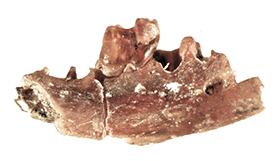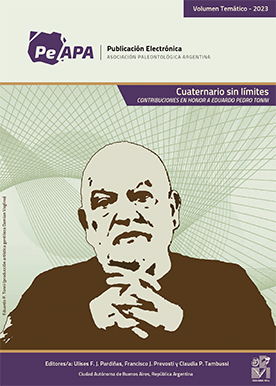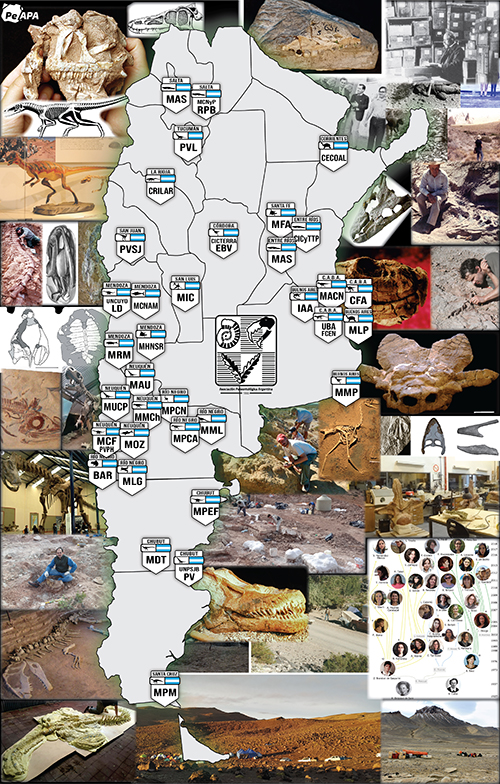BIOSTRATIGRAPHIC REASSIGNMENT OF THE NEOGENE CAENOLESTINES (MARSUPIALIA) OF THE PAMPEAN REGION: THE CASE OF PLIOLESTES TRIPOTAMICUS REIG, 1955
DOI:
https://doi.org/10.5710/PEAPA.29.06.2017.243Keywords:
Huayquerian, Montehermosan, Chapadmalalan, Quequén Salado River, Buenos Aires Province, PliolestesAbstract
The stratigraphic reinterpretation of a controversial paleontological site such as the Quequén Salado River banks allowed refinement of the biochron of the caenolestine marsupial Pliolestes tripotamicus Reig. Two fossil bearing units were proposed for these exposures: a lower one, AUA (Huayquerian) and an upper one, AUB (Montehermosan). P. tripotamicus is found in AUA, but not in AUB or in typical Montehermosan and Chapadmalalan localities, which suggests that this taxon was not part of the Montehermosan–Chapadmalalan assemblages. The other species, P. venetus Goin et al. (Huayquerian), and Caenolestidae n. sp. aff. P. tripotamicus (Chasicoan) indicate the genus was restricted to the Chasicoan–Huayquerian stages/ages. The retraction of the caenolestines toward the Andean Region (where they live today) would have taken place at the beginning of the Pliocene, probably more related to environmental changes than to competence with cricetid rodents as first proposed.
References
Abello, M. A. 2002. Sistemática de Pliolestes Reig 1955 (Marsupialia, Paucituberculata, Caenolestidae), un cenolestino del Mioceno tardío–Plioceno temprano de Argentina central. 17 Jornadas Argentinas de Mastozoología, Resúmenes: 44.
Abello, M. A. 2007. [Sistemática y bioestratigrafía de los Paucituberculata (Mammalia, Marsupialia) del Cenozoico de América del Sur. Ph.D. dissertation, Universidad Nacional de La Plata, La Plata, 381 p. Unpublished].
Abello, M.A. 2013. Analysis of dental homologies and phylogeny of Paucituberculata (Mammalia: Marsupialia). Biological Journal of the Linnean Society 109: 441–465.
Abello, M.A., Posadas, P., and Ortiz Jaureguizar, E. 2010. Biogeografía histórica de los Caenolestidae (Marsupialia, Paucituberculata) del Cenozoico de América del Sur. X Congreso Argentino de Paleontología y Bioestratigrafía y VII Congreso Latinoamericano de Paleontología, Actas R189: 128.
Barbiere, F., Ortiz, P.E., and Pardiñas, U.F.J. 2016. Evolución de los roedores Cricetidae en América del Sur: una visión desde el registro paleontológico. Contribuciones del Museo Argentino de Ciencias Naturales 6: 335–347.
Beilinson, E., Zárate, M.A., Deschamps, C.M., Tomassini, R., Gasparini, G.M., Rabassa, J., Ruella, A., and Tonni, E.P. 2015. Análisis del registro sedimentario y paleontológico de la cuenca inferior del río Quequén Salado (prov. de Buenos Aires, Argentina). 6º Congreso Argentino de Geomorfología y Cuaternario, Resúmenes: 37–38.
Beilinson, E., Gasparini, G.M., Tomassini, R., Zárate, M.A., Deschamps, C.M., Barendregt, R.W., and Rabassa, J. 2017. The Quequén Salado river basin: Geology and biochronostratigraphy of the Mio-Pliocene boundary in the southern Pampean plain, Argentina. Journal of South American Earth Sciences 76: 362–374.
Cione, A.L., and Tonni, E.P. 1995. Chronostratigraphy and “Land-Mammal Ages” in the Cenozoic of southern South America: principles, practices, and the “Uquian” problem. Journal of Paleontology 69: 135–159.
Cione, A.L., and Tonni, E.P. 2005. Bioestratigrafía basada en mamíferos del Cenozoico superior de la provincia de Buenos Aires, Argentina. In: R.E. de Barrio, R.O. Etcheverry, M.F. Caballé, and E. Llambías (eds.), Geología y recursos minerales de la provincia de Buenos Aires. Relatorio del 16° Congreso Geológico Argentino: 183–200.
Deschamps, C.M. 2005. Late Cenozoic mammal bio-chronostratigraphy in southwestern Buenos Aires Province, Argentina. Ameghiniana 42: 733–750.
Deschamps, C.M., and Tomassini, R. 2016. Late Cenozoic vertebrates from the southern Pampean Region: systematic and bio-chronostratigraphic update. PE-APA 16(2): 202–225.
Deschamps, C.M., Vucetich, M.G., Montalvo, C.I., and Zárate, M.A. 2013. Capybaras (Rodentia, Hydrochoeridae, Hydrochoerinae) and their bearing in the calibration of the late Miocene-Pliocene sequences of South America. Journal of South American Earth Sciences 48: 145–158.
Fidalgo, F., De Francesco, O., and Pascual, R. 1975. Geología superficial de la llanura bonaerense (Argentina). Geología de la Provincia de Buenos Aires. 6º Congreso Geológico Argentino (Bahía Blanca), Relatorio: 103–138.
Flynn, J.J., and Swisher III, C.C. 1995. Cenozoic South American Land Mammal Ages: correlation to global geochronologies. In: W.A. Berggren, D.V. Kent, M.-P. Aubry, and J. Hardenbol (Eds.), Geochronology Times Scales and Global Stratigraphic Correlation. Society for Sedimentary Geology, Tulsa, Special Publication 54: 317–333.
Folguera, A., and Zárate, M.A. 2009. La sedimentación neógena continental en el sector extrandino de Argentina central. Revista de la Asociación Geológica Argentina 64: 692–712.
Goin, F.J., Pardiñas, U.F.J., and Lezcano, M. 1994. Un nuevo resto del cenoléstido Pliolestes Reig, 1955 (Mammalia, Marsupialia) del Plioceno de la Provincia de Buenos Aires (Argentina). Ameghiniana 31: 15–21.
Goin, F.J., Montalvo, C.I., and Visconti, G. 2000. Los marsupiales (Mammalia) del Mioceno superior de la Formación Cerro Azul (Provincia de La Pampa, Argentina). Estudios Geológicos 56: 101–126.
Goin, F.J., Candela, A.M., Abello, M.A., and Oliveira, E.V. 2009. Earliest South American paucituberculatans and their significance in understanding of ‘pseudodiprotodont’ marsupial radiations. Zoological Journal of the Linnean Society 155: 867–884.
Kraglievich, L. 1927. Nota preliminar sobre nuevos géneros y especies de roedores de la fauna argentina. Physis 8: 591–598.
Kraglievich, L. 1934. La antigüedad pliocena de las faunas de Monte Hermoso y Chapadmalal, deducida de su comparación con las que les precedieron y sucedieron. Imprenta El Siglo Ilustrado, Montevideo, p. 1–136.
Marshall, L., Hoffstetter, R., and Pascual, R. 1983. Mammals and Stratigraphy: Geochronology of the continental mammal-bearing Tertiary of South America. Paleovertebrata, Mémoire Extraordinaire: 1–93.
Montalvo, C.I., Verzi, D.H., Tallade, P.O., and Zárate, M.A. 2009. Nueva asociación faunística del Huayqueriense (Mioceno tardío) del este de La Pampa, Argentina. Ameghiniana 46, Resúmenes: 38R.
Ojala-Barbour, R., Pinto, C.M., Brito, M.J., Albuja, V.L., Lee, T.E. jr., and Patterson, B.D. 2013. A new species of shrew-opossum (Paucituberculata: Caenolestidae) with a phylogeny of extant caenolestids. Journal of Mammalogy 94: 967–982.
Pardiñas, U.F.J., Prevosti, F.J., Voglino, D., and Cenizo, M. In press. A controversial unit within the Argentine Neogene: the “Irenean” fauna. Ameghiniana. doi: 10.5710/AMGH.20.05.2017.3080
Pascual, R., and Herrera, H.E. 1973. Adiciones al conocimiento de Pliolestes tripotamicus Reig, 1955 (Mammalia, Marsupialia, Caenolestidae) del Plioceno superior de la Argentina. Ameghiniana 10: 36–50.
Pascual, R., Ortega Hinojosa, E.J., Gondar, D., and Tonni, E.P. 1965. Las edades del Cenozoico mamalífero de la Argentina, con especial atención a aquellas del territorio bonaerense. Anales de la Comisión de Investigaciones Científicas de la Provincia de Buenos Aires 6: 165−193.
Prevosti, F.J., and Pardiñas, U.F.J. 2009. Comment on “The oldest South American Cricetidae (Rodentia) and Mustelidae (Carnivora): Late Miocene faunal turnover in central Argentina and the Great American Biotic Interchange” by D.H. Verzi and C.I. Montalvo. Palaeogeography, Palaeoclimatology, Palaeoecology 267 (2008) 284–291. Palaeogeography, Palaeoclimatology, Palaeoecology 280: 543–547.
Reig, O.A. 1955. Un nuevo género y especie de cenolestinos del Plioceno de la Provincia de Buenos Aires (República Argentina). Revista de la Asociación Geológica Argentina 10: 60–71.
Reig, O.A. 1958. Sobre una nueva especie del género "Chapalmatherium" (Rodentia, Hydrochoeridae), del Plioceno del Río Quequén Salado. Physis 21: 32–39.
Schultz, P.H., Zárate, M.A., Hames, W.E., Harris, R.S., Bunch, T.E., Koeberl, C., Renne, P., and Wittke, J. 2006. The record of Miocene impacts in the Argentine Pampas. Meteoritics & Planetary Science 41: 749–771.
Tomassini, R.L., Montalvo, C.I., Deschamps, C.M., and Manera, T. 2013. Biostratigraphy and biochronology of the Monte Hermoso Formation (early Pliocene) at its type locality, Buenos Aires Province, Argentina. Journal of South American Earth Sciences 48: 31–42.
Verzi, D.H., 1999. The dental evidence on the differentiation of the ctenomyine rodents (Caviomorpha, Octodontidae, Ctenomyinae). Acta Theriologica 44: 263–282.
Verzi, D.H., and Montalvo, C.I. 2008. The oldest South American Cricetidae (Rodentia) and Mustelidae (Carnivora): Late Miocene faunal turnover in central Argentina and the Great American Biotic Interchange. Palaeogeography, Palaeoclimatology, Palaeoecology 267: 284–291.
Verzi, D.H., Montalvo, C.I., and Deschamps, C.M. 2008. Biostratigraphy and biochronology of the Late Miocene of central Argentina: evidence from rodents and taphonomy. Geobios 41: 145–155.
Verzi, D.H., Morgan, C.C., and Olivares, A.I. 2015.The history of South American octodontoid rodents and its contribution to evolutionary generalisations. In: P.G. Cox, and L. Hautier (Eds.), Evolution of the Rodents. Advances in Phylogeny, Functional Morphology and Development. Cambridge University Press, Cambridge, p. 139–163.
Vucetich, M.G., Deschamps, C.M., Pérez, M.E., and Montalvo, C.I. 2014. The taxonomic status of the Pliocene capybaras (Rodentia) Phugatherium Ameghino and Chapalmatherium Ameghino. Ameghiniana 51: 173–183.

Downloads
Published
Issue
Section
License
Copyright (c) 2017 Publicación Electrónica de la Asociación Paleontológica Argentina

This work is licensed under a Creative Commons Attribution-NoDerivatives 4.0 International License.

Authors retain copyright and grant the journal right of first publication with the work simultaneously licensed under a CC Attribution-NonCommercial 4.0 that allows others to share the work with an acknowledgement of the work's authorship and initial publication in this journal.






















